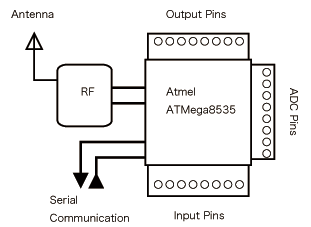|
1. Positioning (EPL vs other plathomes)
There are various types of hardware development environment. EPL proposes a solution to solve problems lies in
existing plathomes in cost-performance and user-friendliness.
AVR
One of the low-cost choice for micro-controller development.
It can be programmed in C, Basic and assembler.
It needs a programming kit such as Atmel STK500 and other programm writer.
It also needs peripheral circuit components such as a crystal, power-source etc.
BasicStamp
Easy to use programmable micro-controller.
Only programmable in PBasic. Relatively expensive.
Wiring
It can be programmed with a high-level proprietary language that is similar to Processing sketch coding
structure. It has some high-level functions such as PWM etc.
OOPic
Lots of fancy functions that can be controlled in object-oriented programming environment.
Expensive. It works only with OOPic programming environment.
EPL
EPL is more like a converter than a programmable controller.
It can be controlled from various kinds of existing programming environment such as Max/MSP, Processing,
Macromedia Director, C/C++, Java, etc.
It also has a built-in wireless communication capability to access to sensor and to operate actuators.
Pin out/in and analog digital converter can be also used. (which is enough for most of projects).
Unit price is around $20.

2. Mechanism

I/O pins
EPL has 8 bits input pin and 8bits output pin that are directly connected to the built-in AVR
microcontroller. It can be controlled by wireless communication
ADC
EPL has 6 channel 10 bits ADC ports. Currently the resolution is compressed to 8bit length because of the
spec of wireless communication protocol. It can be extended when needed. (However, it is rare that you need 10 bit
resolution.)
Wireless capability
EPL has built-in proprietary protocol stack for wireless communication. It is a CSMA/CA-based communication
protocol that is specially customized for a class environment where a large number of students use modules at the
same time.

Interfacing
I am designing an programming interface for Processing which allows a user to program EPL modules easily. It
allows easy acess to I/O pins and ADC.
We provide EPL module station, which collects sensor data from modules and works as an interface between
modules and PCs via serial port (and possibly USB).
3. Cost
Print-board
Currently, EPL modules are manually manufactured by etching. It would be reasonable to use a PCB prototyping
service such as ExpressPCB. It would be cheaper when ordered by a large amount.
Micro-controller
EPL is built with Atmel ATmega8535 microcontroller. It has minimum functions and computational resource to
handle wireless communication and sensor data retrieval. Its unit price is around $5. Of course, it becomes cheaper
when ordered by a large amount of unit.
Wireless chip
Currently, EPL uses LINX RXM-433 and TXM-433 chip for wireless data transmission/receiving. Thinking of the
possibility that the modules are used by students in the same physical space at the same time, improvements in
communication quality and speed is required. I am currently working with one Ph.D student from Keio University in
Japan on this. We are thinking about using Zigbee compatible chip by ChipCon or a wireless chip manufactured by
Nordic Semiconductor (http://www.nvlsi.no/index.cfm?obj=product&act=display&pro=79) that can handle 2.4 GHz
frequency band for faster and stable wireless communication. The cost for chip is around $7 per a unit.
4. Related Projects
Smart-Its
http://www.smart-its.org/
Wiring
http://wiring.org.co/
Smart Dust
http://robotics.eecs.berkeley.edu/~pister/SmartDust/
|